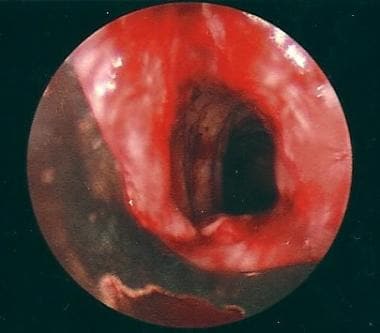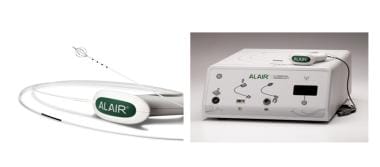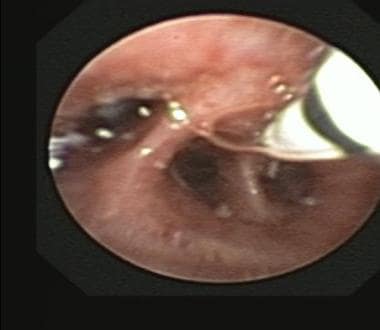Bronchoplasty Technique
Rigid and flexible bronchoscopies are performed to delineate the anatomy and degree of bronchial involvement. Operative strategies are based on frozen section results from biopsies.
The type of bronchoplastic procedure in individual cases is selected according to the location and extent of the pathologic lesion; modifications are performed according to the operative findings. The most commonly performed bronchoplastic procedure is a sleeve lobectomy. The principal aim of the procedure is to conserve as much of the healthy lung tissue as possible, while providing satisfactory cancer clearance.
Open Thoracotomy
A standard posterolateral thoracotomy is used for all bronchoplasties. Standard surgical technique is used for lobectomy until the bronchus is encountered. [2, 3, 19]
The area of involved bronchus is carefully dissected to preserve peribronchial blood supply. Proximal and distal points of transection are determined, and the bronchus is precisely divided. Additional segments of proximal and distal margin are removed for frozen section evaluation to confirm absence of tumor involvement.
Full-thickness traction sutures of 2-0 Vicryl are placed proximally and distally in the midlateral position of the bronchus and are left in place at the completion of the procedure. The anastomosis is performed in open fashion to allow precise placement of sutures commencing posteriorly. Anastomotic sutures of 4-0 Vicryl are placed so that the knots are outside the lumen. They are placed 3 mm deep and spaced accordingly to accommodate any size discrepancy that exists between the bronchi.
With the traction sutures pulled together and tied, each individual anastomotic suture is tied in the reverse order of placement. Once the anastomosis is completed, saline solution is placed in the pleural cavity, the lung is reexpanded, and the anastomosis is checked for air leaks. The anastomosis is wrapped with either pericardial fat or pleural flap or intercostal muscle flap for additional buttressing.
Flexible bronchoscopy is required at this time to confirm the alignment, patency, and adequacy of the anastomosis. Chest tubes are placed and connected to a water-seal device with suction.
Video-Assisted Thoracoscopic Surgery
Video-assisted thoracoscopic surgery (VATS) is an option for most patients with thoracic pathology. This technique has been shown to have better outcomes, less pain, and shorter recovery time than the open approach. [20, 21, 22] VATS is a better alternative to thoracotomy and is performed under general anesthesia using a camera and 2 trocar ports. The VATS technique is very similar to the open technique, except endoscopic instruments are used to retract and dissect and visualization is via an image obtained with the thoracoscope projected on a screen. [23, 24]
A standard thoracoscopy is performed with 2-3 10-mm incisions: a camera port is placed in the anterior axillary line in the seventh or eighth intercostal space; an anterior port is placed between the latissimus dorsi and pectoralis major muscles in the fourth or fifth intercostal space; and a posterior port is placed adjacent to the scapula in the fifth or sixth intercostal space.
Through working thoracoscopy ports, an exploratory thoracoscopy is performed. Subsequently, the anterior thoracoscopy incision is extended to create a 3- to 5-cm muscle-sparing access incision to proceed with VATS lobectomy or wedge bronchoplasty or sleeve resection and allow for removal of the specimen. As in open lobectomy, the pulmonary vein branches from the targeted lobe are identified and dissected before their division using an endoscopic stapling device. Pulmonary artery branches and the bronchus are identified, dissected, stapled, and divided in a similar manner.
The specimen is removed from the pleural space using a plastic bag to avoid port-site contamination. After the lobectomy or sleeve resection is completed, a hilar and mediastinal lymphadenectomy or lymph node sampling is performed. Ends of bronchial stump are sent for frozen section to ensure tumor-free margin. Bronchial stump anastomosis is challenging, especially in VATS, because of limited access. Continuos sutures should be tied. A sliding knot technique combining with hitch and bend knots as described by Nakanishi is helpful. [6] The incisions are closed after a chest tube is placed in the inferior thoracoscopy port. The chest tube is connected to the water seal device.
Balloon Bronchoplasty
Bronchoscopic balloon dilation is a simple, nontraumatic, minimally invasive, safe, rapid method to dilate a stenosis and restore adequate airflow. It may be used with fluoroscopic guidance over a guide wire or under direct vision. It does not require general anesthesia.
Balloon bronchoplasty is most commonly used with high long-term success for nonmalignant causes of airway stenosis, but it is also used in malignant diseases.
The balloon should be silicone based and able to provide radial force. The inflation syringe must have a pressure gauge, and knowledge of burst pressure must be observed. The balloon is usually filled with saline until full deployment is reached with the help of a pressure-measuring syringe, to a prespecified pressure unit ranging from 6-12 atm in adults. Inflation diameter ranges from 4-20 mm, with a length of 4-8 cm. The final desired diameter is usually the normal diameter immediately proximal or distal to the stenosis. Each dilation can be maintained for 15-60 seconds and repeated 2-3 times, with sequentially larger-diameter balloons (see the image below). If the cartilage has been compromised, a stent is needed to support the airway. [25]

--> Post balloon dilation.
Balloon dilation and stent placement are safe and effective for bronchial strictures and bronchomalacia after lung transplantation, resulting in significant improvement in pulmonary function testing (PFT) results. [26, 27]
Di Felice et al compared the efficacy and safety of balloon bronchoplasty versus rigid bronchoplasty for the treatment of benign subglottic and tracheal stenosis (SGTS) and found that the 2 approaches were equally safe and effective for early management of benign SGTS. [28]
Thermal Bronchoplasty
Thermal bronchoplasty, or bronchial thermoplasty requires 3 separate outpatient bronchoscopic procedures 3 weeks apart: one for each lower lobe of the lung and another for both upper lobes.
Using a flexible bronchoscope, a catheter is deployed into the airways, and controlled radiofrequency energy is delivered to a wire basket attached to the top of the catheter using the controller system, in which thermal energy warms the lining of targeted airways to reduce airway smooth muscle (ASM) mass. Bronchial thermoplasty is intended to reduce, debulk, or partially eliminate smooth muscle tissue (see the images below). [29, 30]
Bronchial thermoplasty can reduce the frequency and severity of asthma attacks in adults with severe asthma, but it should be considered only when other treatments have been unsuccessful in controlling asthma attacks in adults with severe athma.
Chadhuri et al found that that the efficacy of bronchial thermoplasty is sustained for 10 years or more, with an acceptable safety profile. [31]
 Alair controller and catheter. " />
Alair controller and catheter. " />
--> Alair controller and catheter.

--> Alair catheter deployed in the subsegmental bronchus.
References
- Lee M, Razi SS. Pulmonary sleeve resection. StatPearls. Treasure Island, FL: StatPearls Publishing; 2022 Jan. 2022 Jun 5. [Full Text].
- Raphael Bueno, MD, John C. Wain, MD, Cameron D. Wright, MD. Bronchoplasty in the Management of Low-Grade Airway Neoplasms and Benign Bronchial Stenoses. Ann Thorac Surg. 1996;62:824-828:[QxMD MEDLINE Link].
- Anjum Jalal, K. Jeyasingham. Bronchoplasty for malignant and benign conditions: a retrospective study of 44 cases. European Journal of Cardio-thoracic Surgery. 2000; 370-376:[Full Text].
- Nagayasu T, Yamasaki N, Tsuchiya T, Matsumoto K, Miyazaki T, Hatachi G, et al. The evolution of bronchoplasty and broncho-angioplasty as treatments for lung cancer: evaluation of 30 years of data from a single institution. Eur J Cardiothorac Surg. 2016 Jan. 49 (1):300-6. [QxMD MEDLINE Link].
- Cayetano KS, Chan AL, Albertson TE, Yoneda KY. Bronchial Thermoplasty: A New Treatment Paradigm for Severe Persistent Asthma. Clin Rev Allergy Immunol. 2011 Nov 22:[QxMD MEDLINE Link].
- Nakanishi K. Video-Assisted Thoracic Surgery Lobectomy With Bronchoplasty for Lung Cancer: Initial Experience and Techniques. Ann Thorac Surg. 2007;84:191-195:[QxMD MEDLINE Link].
- Whitson BA, Andrade RS, Boettcher A, Bardales R, Kratzke RA, Dahlberg PS, et al. Video-assisted thoracoscopic surgery is more favorable than thoracotomy for resection of clinical stage I non-small cell lung cancer. Ann Thorac Surg. 2007 Jun;83(6):1965-70:[QxMD MEDLINE Link].
- Krüger M, Uschinsky K, Hässler K, Engelmann C. Postoperative complications after bronchoplastic procedures in the treatment of bronchial malignancies. Eur J Cardiothorac Surg. 1998 Jul. 14 (1):46-52; discussion 52-3. [QxMD MEDLINE Link]. [Full Text].
- Peng Z, Mei J, Liu C, et al. Risk factors and outcomes of bronchopleural fistula after bronchoplasty in patients with non-small cell lung cancer: a retrospective multivariate analysis. Transl Lung Cancer Res. 2022 May. 11 (5):744-56. [QxMD MEDLINE Link].
- Faccioli E, Dell'Amore A, Ferrigno P, et al. Surgical management of post-transplant bronchial stenoses: a single-center experience. Surg Today. 2022 Mar. 52 (3):449-57. [QxMD MEDLINE Link].
- End A, Hollaus P, Pentsch A, et al. Bronchoplastic procedures in malignant and nonmalignant disease: multivariable analysis of 144 cases. J Thorac Cardiovasc Surg. 2000 Jul. 120 (1):119-27. [QxMD MEDLINE Link]. [Full Text].
- Eung-Sirk Lee, Seung-Il Park, Yong Hee Kim, Chi Hoon Bae, Hye Won Moon, Mi Sun Chun, et al. Comparison of Operative Mortality and Complications between Bronchoplastic Lobectomy and Pneumonectomy in Lung Cancer Patients. J Korean Med Sci. 2007 February; 22(1): 43–47:[QxMD MEDLINE Link].
- Icard P, Regnard JF, Guibert L,et al. Survival and prognostic factors in patients undergoing parenchymal saving bronchoplastic operation for primary lung cancer: a series of 110 consecutive cases. Eur J Cardiothorac Surg. 1999 Apr. 15 (4):426-32. [QxMD MEDLINE Link]. [Full Text].
- Onaitis MW, Furnary AP, Kosinski AS, Kim S, Boffa D, Tong BC, et al. Prediction of Long-Term Survival After Lung Cancer Surgery for Elderly Patients in The Society of Thoracic Surgeons General Thoracic Surgery Database. Ann Thorac Surg. 2018 Jan. 105 (1):309-316. [QxMD MEDLINE Link]. [Full Text].
- Deslauriers J, Tronc F, Grégoire J. History and current status of bronchoplastic surgery for lung cancer. Gen Thorac Cardiovasc Surg. 2009 Jan;57(1):3-9. [QxMD MEDLINE Link].
- Sheski FD, Mathur PN. Long-term results of fiberoptic bronchoscopic balloon dilation in the management of benign tracheobronchial stenosis. Chest. 1998 Sep. 114 (3):796-800. [QxMD MEDLINE Link]. [Full Text].
- Tedder M, Anstadt MP, Tedder SD, Lowe JE. Current morbidity, mortality, and survival after bronchoplastic procedures for malignancy. Ann Thorac Surg. 1992 Aug;54(2):387-91.:[QxMD MEDLINE Link].
- Kocher GJ, Gioutsos KP, Ahler M, Funke-Chambour M, Ott SR, Dorn P, et al. Perioperative Lung Function Monitoring for Anatomic Lung Resections. Ann Thorac Surg. 2017 Nov. 104 (5):1725-1732. [QxMD MEDLINE Link]. [Full Text].
- Kotoulas C, Lazopoulos G, Foroulis C, et al. Wedge resection of the bronchus: an alternative bronchoplastic technique for preservation of lung tissue. Eur J Cardiothorac Surg. 2001 Oct. 20 (4):679-83. [QxMD MEDLINE Link]. [Full Text].
- Laursen LØ, Petersen RH, Hansen HJ, Jensen TK, Ravn J, Konge L. Video-assisted thoracoscopic surgery lobectomy for lung cancer is associated with a lower 30-day morbidity compared with lobectomy by thoracotomy. Eur J Cardiothorac Surg. 2016 Mar. 49 (3):870-5. [QxMD MEDLINE Link]. [Full Text].
- Bendixen M, Jørgensen OD, Kronborg C, Andersen C, Licht PB. Postoperative pain and quality of life after lobectomy via video-assisted thoracoscopic surgery or anterolateral thoracotomy for early stage lung cancer: a randomised controlled trial. Lancet Oncol. 2016 Jun. 17 (6):836-844. [QxMD MEDLINE Link].
- Agasthian T. Video-assisted thoracoscopic bronchoplasty. J Vis Surg. 2017. 3:12. [QxMD MEDLINE Link].
- Sandra C. Tomaszek, MD, Stephen D. Cassivi, MD, MSc, K. Robert Shen, et al. Clinical Outcomes of Video-Assisted Thoracoscopic Lobectomy. Mayo Clin Proc. 2009 June; 84(6): 509–513. [QxMD MEDLINE Link].
- Kamiyoshihara M, Nagashima T, Igai H, Atsumi J, Ibe T, Kakegawa S, et al. Video-assisted thoracic lobectomy with bronchoplasty for lung cancer, with special reference to methodology. Interact Cardiovasc Thorac Surg. 2011 Apr;12(4):534-8. [QxMD MEDLINE Link].
- [Guideline] European Respiratory Society/American Thoracic Society. ERS/ATS statement on interventional pulmonology. European Respiratory Society/American Thoracic Society. Eur Respir J. 2002 Feb. 19 (2):356-73. [QxMD MEDLINE Link]. [Full Text].
- Orons PD, Amesur NB, Dauber JH, Zajko AB, Keenan RJ, Iacono AT. Balloon dilation and endobronchial stent placement for bronchial strictures after lung transplantation. J Vasc Interv Radiol. 2000 Jan;11(1):89-99. [QxMD MEDLINE Link].
- Amesur NB, Orons PD, Iacono AT. Interventional techniques in the management of airway complications following lung transplantation. Semin Intervent Radiol. 2004 Dec;21(4):283-95. [QxMD MEDLINE Link].
- Di Felice C, Alraiyes AH, Gillespie C, et al. Short-term endoscopic outcomes of balloon and rigid bronchoplasty in the management of benign subglottic and tracheal stenosis. J Bronchology Interv Pulmonol. 2022 Apr 5. doi: 10.1097/LBR.0000000000000852. [QxMD MEDLINE Link].
- Castro M, Rubin AS, Laviolette M, et al. Effectiveness and safety of bronchial thermoplasty in the treatment of severe asthma: a multicenter, randomized, double-blind, sham-controlled clinical trial. Am J Respir Crit Care Med. 2010 Jan 15. 181 (2):116-24. [QxMD MEDLINE Link].
- AIR Trial Study Group. Asthma control during the year after bronchial thermoplasty. N Engl J Med. 2007 Mar 29. 356 (13):1327-37. [QxMD MEDLINE Link]. [Full Text].
- BT10+ Study Group. Safety and effectiveness of bronchial thermoplasty after 10 years in patients with persistent asthma (BT10+): a follow-up of three randomised controlled trials. Lancet Respir Med. 2021 May. 9 (5):457-466. [QxMD MEDLINE Link].
- Ohsumi A, Kayawake H, Yamada Y, et al. Strategy for lung parenchyma-sparing bronchial resection: a case series report. Interact Cardiovasc Thorac Surg. 2022 Jul 9. 35 (2):ivac166. [QxMD MEDLINE Link].
- Latos M, Urlik M, Nęcki M, et al. Influence of bronchoscopic interventions on graft function of double lung transplant recipients due to cystic fibrosis. Transplant Proc. 2022 May. 54 (4):1092-6. [QxMD MEDLINE Link].
- Lowe JE, Bridgman AH, Sabiston DC Jr. The role of bronchoplastic procedures in the surgical management of benign and malignant pulmonary lesions. J Thorac Cardiovasc Surg. 1982 Feb;83(2):227-34.:[QxMD MEDLINE Link].
- Torrego A, Solà I, Munoz AM, et al. Bronchial thermoplasty for moderate or severe persistent asthma in adults. Cochrane Database Syst Rev. 2014 Mar 3. 3:CD009910. [QxMD MEDLINE Link].



 Alair controller and catheter. " />
Alair controller and catheter. " />